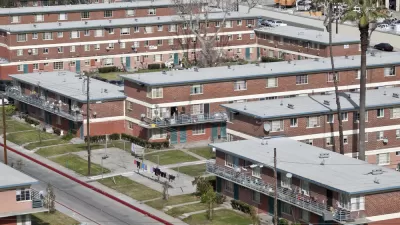Metropolitan region's make up a major part of the U.S. in terms of population and economic activity. Accordingly, the Brookings Institution was surprised to see how little of the government's first year stimulus package went to those areas.
Robert Puentes offers this analysis of the spending, including the recent TIGER grants from the Department of Transportation.
"Because our 100 largest metropolitan areas harbor two-thirds of our population and generate 75 percent of our gross domestic product, it makes sense to leverage that economic might when making infrastructure decisions. Metropolitan areas are agglomerations of innovation and human capital. Metros offer more sustainable development patterns, which are supported by a range of transportation and infrastructure choices. In that regard, metropolitan areas are also where 72 percent of the seaport tonnage arrives and departs; where 78 percent of our interstate miles are travelled; where 92 percent of air passengers and transit miles are ridden, and where 93 percent of rail passengers board.
So what do we know so far about the transportation recovery spending? Analyzing the latest Recovery.gov data we find that, overall, just 41 percent of the projects and 59 percent of the transportation spending occurred in the 100 largest metropolitan areas."
FULL STORY: TIGER’s Tale and Lessons for Stimulus Spending

Alabama: Trump Terminates Settlements for Black Communities Harmed By Raw Sewage
Trump deemed the landmark civil rights agreement “illegal DEI and environmental justice policy.”

Planetizen Federal Action Tracker
A weekly monitor of how Trump’s orders and actions are impacting planners and planning in America.

The 120 Year Old Tiny Home Villages That Sheltered San Francisco’s Earthquake Refugees
More than a century ago, San Francisco mobilized to house thousands of residents displaced by the 1906 earthquake. Could their strategy offer a model for the present?

In Both Crashes and Crime, Public Transportation is Far Safer than Driving
Contrary to popular assumptions, public transportation has far lower crash and crime rates than automobile travel. For safer communities, improve and encourage transit travel.

Report: Zoning Reforms Should Complement Nashville’s Ambitious Transit Plan
Without reform, restrictive zoning codes will limit the impact of the city’s planned transit expansion and could exclude some of the residents who depend on transit the most.

Judge Orders Release of Frozen IRA, IIJA Funding
The decision is a victory for environmental groups who charged that freezing funds for critical infrastructure and disaster response programs caused “real and irreparable harm” to communities.
Urban Design for Planners 1: Software Tools
This six-course series explores essential urban design concepts using open source software and equips planners with the tools they need to participate fully in the urban design process.
Planning for Universal Design
Learn the tools for implementing Universal Design in planning regulations.
Clanton & Associates, Inc.
Jessamine County Fiscal Court
Institute for Housing and Urban Development Studies (IHS)
City of Grandview
Harvard GSD Executive Education
Toledo-Lucas County Plan Commissions
Salt Lake City
NYU Wagner Graduate School of Public Service



























